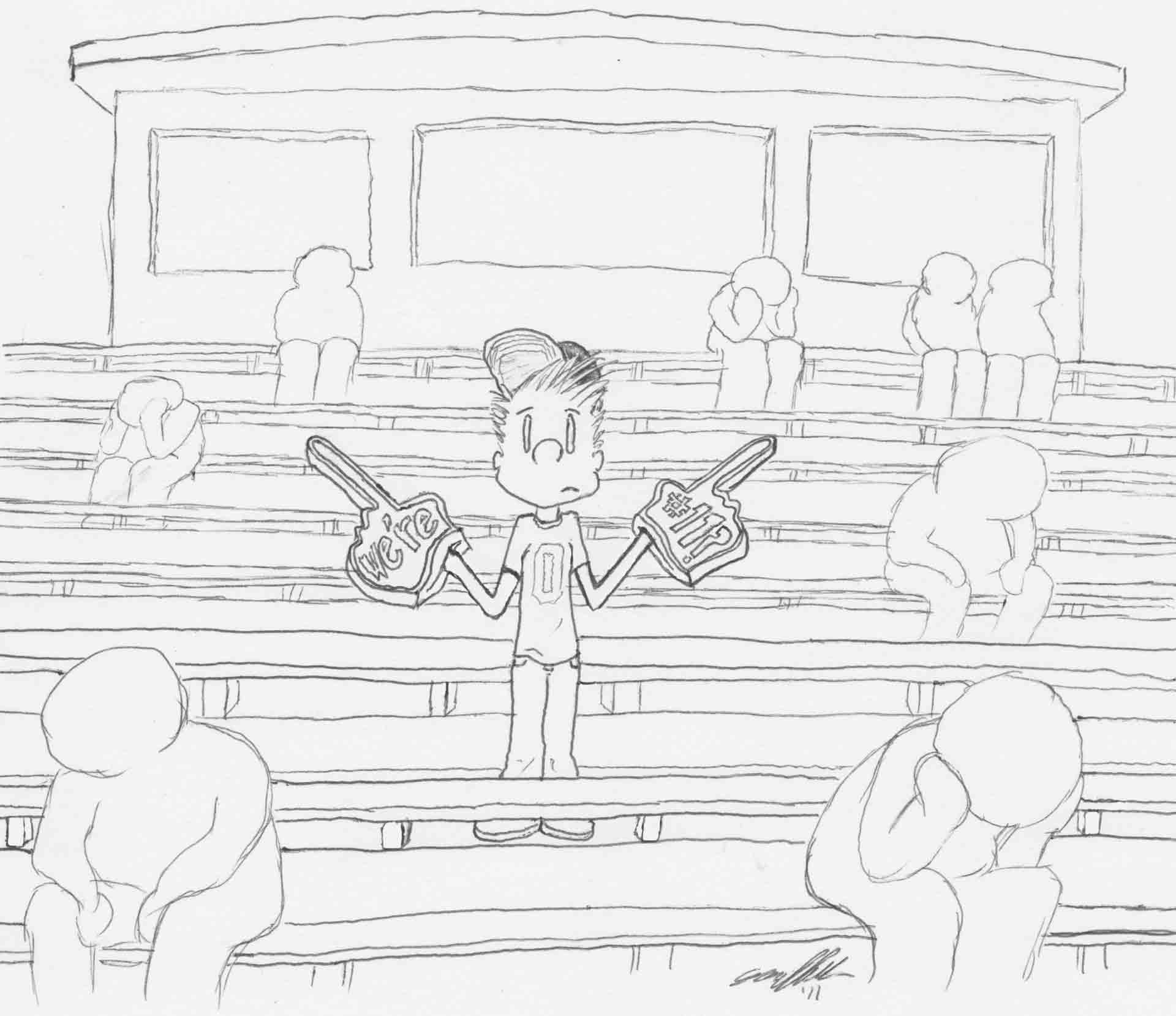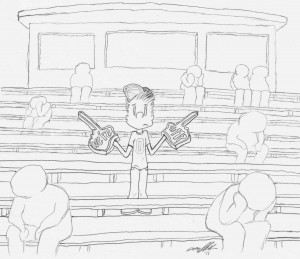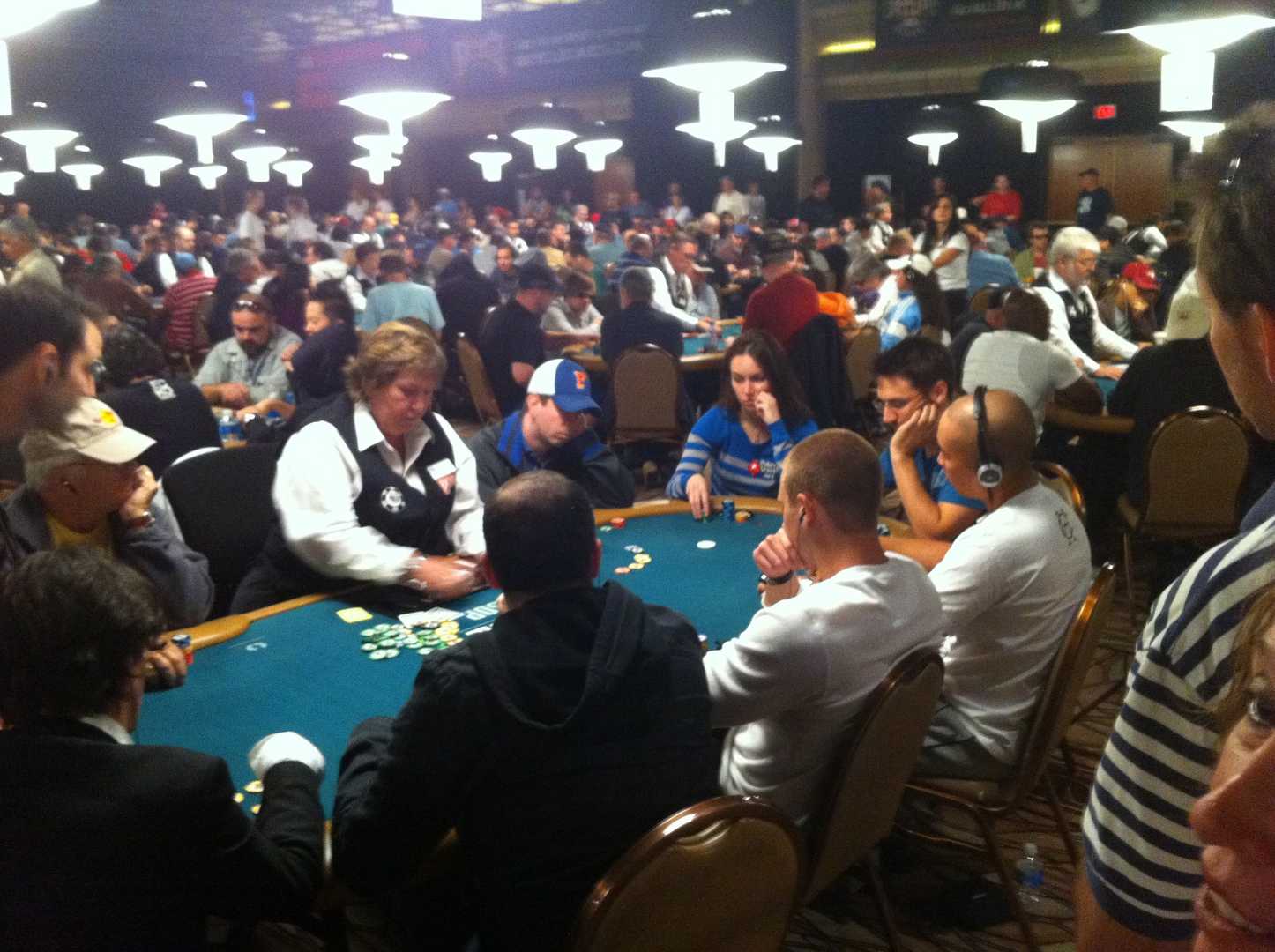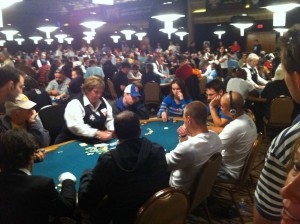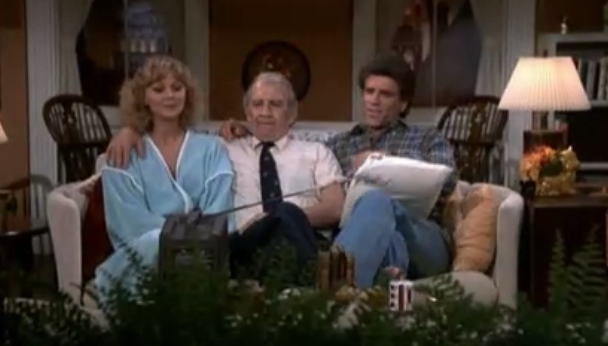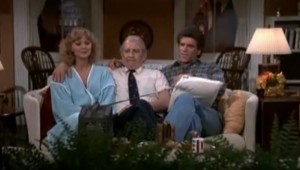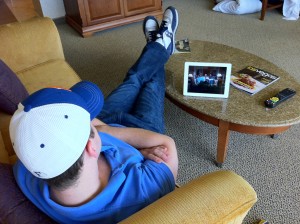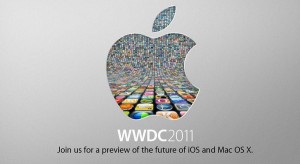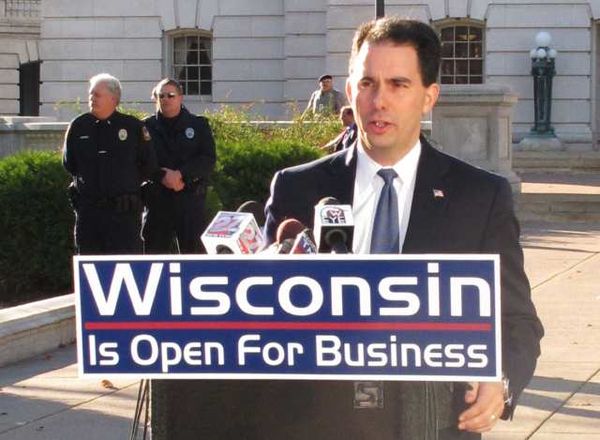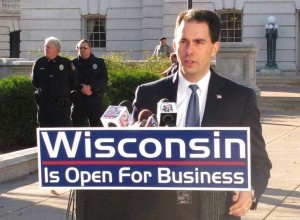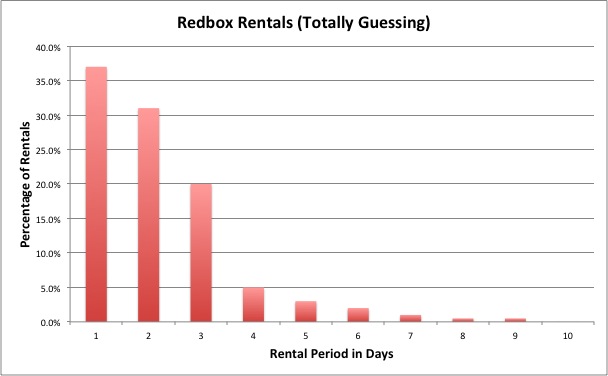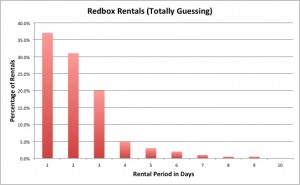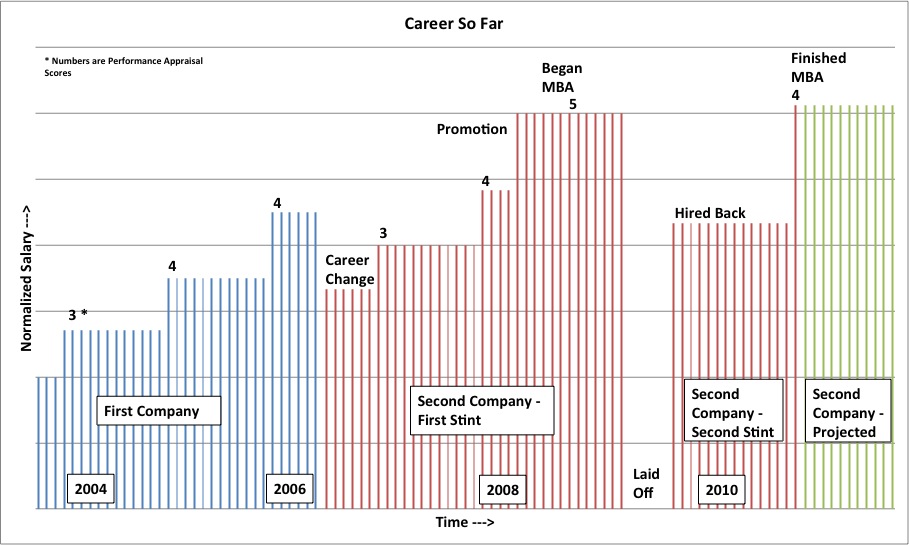On ESPN’s Tuesday night WSOP coverage of the Main Event, there was a really big hand between Vanessa Rousso and David Bach. I was in the audience when the hand went down. I had several conversations about the hand over the following days, and it turns out this hand is a very, very interesting one.
I haven’t seen too much analysis of this particular hand, and since I was able to talk to several pros about it right after it happened, I figure I should write something up.
DISCLAIMER: These aren’t exclusively my thoughts. I mean, they are now, but my thoughts are really a mishmash of discussions that I had with various people about this hand. So I’m not putting this out there as some kind of original thought, but more just trying to convey a summary of the different conversations I had about this particular hand. Also, full disclosure, I’m co-writing two books with Vanessa right now, so I’m probably biased. I’m trying not to be, but I can’t make any promises. I’ve never met David or Joe.
SECOND DISCLAIMER: I’m not writing this up to show whether or not David, Joe and Vanessa played the hand “correctly”. I just thought it was a fascinating hand and I wanted to dig into it to see if I could figure out what they might have been thinking. There’s no gotcha. I do occasionally state my preference when there are multiple actions to be taken, but I’m not looking to pass judgement on whether anyone made obviously “right” or “wrong” decisions in this particular hand.
Here we go!
Blinds 3,000/6,000/1,000
Average stack is about 300,000
Starting stacks:
David Bach (BB – Big Blind) 456,000: Qh Jh – Known to be a tricky, aggressive player who is not afraid to get his chips in the middle. Was short as recently as a couple levels ago, and recently doubled up through Vanessa with aces against her AK.
Joe Serock (UTG+1 – second to act) 151,000: Tc 9c – He was unknown to me at the time, and I don’t think that either Vanessa or David had much history with him.
Vanessa Rousso (MP – middle position) 732,000: 6d 6h – Has been playing aggressively and steadily chipping up without showing many hands. Has made some difficult calls earlier in the day.
I think a major factor in this hand is the stack sizes relative to the average stack. Vanessa has almost 2.5 times the average, David has about 1.5 times the average and Joe has about half the average. The WSOP Main Event is a very slow structure, which means there’s a lot of room for patient, calculated play. Although Joe is short, he’s not desperate with an M of 8 (or 25 big blinds). David and Vanessa both have very, very comfortable stacks.
Pre-fop: (18,000): Joe raises to 13,000. Vanessa calls. David calls from the big blind. Everyone else folds.
Joe’s raise is a little loose given his chip stack and his position at the table. T9s seems a little light to be raising with his stack in early position. That said, it’s not a bad raise, and a lot of players will make this raise because they trust their post-flop abilities and because of the way the game is played today.
Vanessa’s call is standard. She doesn’t want to 3-bet and give Joe the opportunity to 4-bet all-in (she would have an awkward decision if she 3-bet and then he shoved, and she would probably have to fold after putting about 30k in the pot). She also needs other callers to increase her implied odds to flop a set. Joe’s stack really isn’t deep enough for Vanessa to try to flop a set against him heads-up, although she does have position and she’s getting about 11-to-1 total implied odds if she can get his whole stack. She’s really looking for other callers to increase her potential payoff if she flops a set. She could also look for opportunities to outplay Joe after the flop by leveraging his stack size, which will likely make his post-flop decisions tricky.
David’s decision is very similar to Vanessa’s. Folding would be pretty bad here. I think calling is the best play if he thinks Joe is playing reasonably tight, and since Vanessa has enough chips to comfortably call a 3-bet in position. A 3-bet would be tricky for the same reasons it was would have been tricky for Vanessa. Additionally, David would probably have to contend with Vanessa (who has position on him) if he 3-bet. QJs can flop a lot of big hands, and he’s getting a great price to call (he’s getting about 5.5-to-1).
Flop (46,500): Th 9s 6c. David checks. Joe bets 25,000. Vanessa raises to 50,000. David check-raises all-in for 442,000 total. Joe folds. Vanessa calls.
David has a lot of options when he’s first to act on this flop. He’s flopped an open-ended straight draw, a back-door flush draw, and two overcards. This is a pretty strong hand assuming he’s not up against an overpair, a set, or two pair. Worst case, he’s about a 2.5-to-1 dog, and he could be a favorite against a lot of hands like an overpair, AK, AT, and pretty close to even money against a hand like JT.
He could lead small, hoping to just win the pot immediately or to induce a smallish raise from Joe so that he could then semi-bluff all-in. The small lead (also called a “weak lead” or a “donkbet”) is often perceived as weak (because it usually is), and a lot of good players will automatically raise this sort of weak lead with any two cards, hoping to take the pot away from the leader. I call this move the “bet, 3-bet-shove” and I like to use it with big draws and over pairs against aggressive players. The issue here is that Joe is a little too short-stacked for this move to work effectively.
He decides to check. I doubt he intended to check-raise all-in at this point. He was keeping his options open for a standard check-raise, a check-call, or maybe a check-shove if the action was just right.
Joe flopped top two pair and I’m sure he was throwing a mental parade. With his stack size and this flop, he’s got to be pretty sure he can double up if either of his opponents has some kind of hand. He’s trying to figure out how to get all his chips in the middle as soon as possible. He continues, betting 25k (just over half the pot), which is standard. He’s hoping someone will raise him so he can just get his chips in now, while he’s almost certain to have the best hand.
Vanessa has flopped bottom set and is also probably throwing a mental parade. She has two options: flat-call or raise. There are a few problems with flat-calling. If Joe has a hand, she wants to get him to commit his stack now, before any scare-cards come. She obviously can’t do that by just calling. A seven or eight would almost totally kill her action unless Joe outruns her and makes a straight. There are some overcards that could scare him as well. If he flopped top pair, then he might shut down on the turn if an overcard comes and doesn’t improve his hand.
Another issue is that if she just calls here, then David is yet to act and will be able to call with a lot of funky draws and pretty decent pot odds. He’ll be getting 4-to-1 to call 25k against two opponents. He could definitely call with an open-ended straight draw, but he may be able to call with some gutshot straight draws as well, hoping for good implied odds if he hits the longshot. If she just calls here, David’s going to call with a lot of hands, and there could be a lot of scare cards for both her and Joe on the turn. David has a lot of chips and she needs to make sure she knows where he’s at in the hand if he continues. By just calling, she would allow him to call with a wide range of hands and she wouldn’t get any more information about what he has. There is one potential benefit to flat-calling, though: David is known to be tricky and aggressive and may be looking to check-raise. If he were to check-raise, Joe may go ahead and move his chips in, allowing Vanessa to then move her chips in and shut David out while isolating against Joe.
On balance, the possibility that David would check-raise and re-open the action is pretty small, and the downside of flat-calling is pretty great. She decides to min-raise, which is a common play in her arsenal. Her goal is to isolate against Joe and hope he flopped some kind of hand so she can get him to commit his stack. A secondary goal is to sort of “squeeze” David either out of the pot or into uncomfortable territory. The stack sizes in this hand will make David’s next decision very difficult because of this min-raise. They don’t really show this on the edited broadcast, but David took at least three minutes to make his next decision. He took so long because it was a really tough decision, mostly thanks to this min-raise and the players’ stack sizes.
Vanessa is communicating a lot with her min-raise. It is a small raise in absolute terms, but it essentially commits her to calling if Joe moves all-in. She’s letting Joe know that she’s willing to play for his stack, but she’s also telling David that she has a real hand and that she’s not afraid to commit 130,000 chips with her hand. Her min-raise could also be read as a marginal hand (AT, JJ) that is trying to isolate against Joe’s apparent not-quite-as-good hand. She’s also giving Joe some rope in case he doesn’t believe that she’s committed to calling his all-in because her min-raise is small enough that it might look like she’s just putting in a probe-raise and that she might consider folding if he shoves. If Joe might take this bait, so might David.
Interpreting Vanessa’s min-raise is a critical factor in the hand. If David and Joe read this min-raise correctly, they both wiggle off the hook and save a bunch of chips. If they read it incorrectly, they could get into some pretty deep trouble.
David sees that Joe made a continuation bet (c-bet), and that Vanessa min-raised that c-bet. Joe’s c-bet doesn’t necessarily mean he has a hand. Many players will continue almost 100% of the time. The caveat is that this board should be pretty scary for Joe since Vanessa and David both flat-called and this type of board hits a lot of hands that would just flat-call pre-flop. In general, I don’t think Joe would be continuing 100% of the time here since it’s so unlikely that he’ll get both opponents to fold for one bet on the flop given the texture of the board and their deep chip stacks. He simply can’t afford to use his chips to c-bet in a situation where his c-bet is often unlikely to work. So his c-bet does communicate some strength, but it’s still a c-bet and certainly doesn’t mean that he has the nuts or anything like that. Vanessa’s min-raise could mean a lot of things (as discussed above).
David has a very big draw, so he has a few options.
He could call. Assuming that one or both of his overcards are live, he is getting pretty close to the odds he needs to just call the bet. If he knew for certain that Joe would also just call, then he’d be getting great odds to hit his draw.
The issue is that David can’t close the action. If he calls, Joe can still re-open the action and re-raise, so David can’t just consider his own pot-odds here, but he has to consider that Joe might move in if David just calls. If Joe moves in, then Vanessa can move in and shut David out. This is one reason Vanessa’s min-raise is sort of a squeeze on David–he’s stuck between two players who can keep putting chips in regardless of what David does. So flat-calling Vanessa’s raise really doesn’t look like a good option.
He could fold. He’s in for 13,000 so far, and Joe has shown quite a bit of strength. Despite Joe’s show of strength, Vanessa has min-raised him and appears to have committed herself to calling his all-in if it comes to that. She’s showing that even though Joe is showing some strength, she’s even stronger (or at least she’s stronger than the range of hands she puts Joe on). Their combined show of strength may also tell David something useful: his overcards may not be live. If his overcards aren’t live, then all he has is an open-ended straight draw. He’s definitely not getting explicit odds to call and see only one card with a straight draw, especially considering that his call wouldn’t close the action (so there’s no guarantee he’d even get to see the turn if he put in chips to call).
He could make a standard re-raise. Vanessa’s min-raise is to 50,000, so David could make it something like 125,000 or 150,000 if he wanted. This kind of raise would commit about 35% of his stack and could be dangerous since both Joe and Vanessa have shown strength so far. Joe may be planning to move all-in when the action is back on him, and Vanessa seems unafraid of that possibility. If David re-raises, the best result is that both Joe and Vanessa fold, but the action so far just doesn’t indicate that is very likely. The worst-case scenario is that he re-raises to 150,000, Joe calls all-in and then Vanessa re-raises all-in for all his chips. If that happened, David would be getting such great put-odds (about 5-to-2) that he would almost certainly have to call. He can’t fold an open-ended straight draw to the nuts with two cards to come getting that price. So by just putting in a normal re-raise, he could possibly be committing himself to calling all-in with a straight draw. That’s not really how a good player wants to play his draws. If he can, he’d prefer to be the one moving all-in so that at least he has some fold equity.
He could move all-in. Although Joe has shown quite a bit of strength, Vanessa did min-raise him and if David moves all-in, Joe has to think someone has a really, really big hand. Joe would probably have to fold an overpair in this situation, and of course he would fold all the hands that were just naked c-bets. Once it got back to Vanessa, she would have a really difficult decision to make for about 60% of her stack. As I said before, her min-raise probably either means she has a pretty good hand that she thinks is better than Joe’s range of hands, or it means she has a really big hand. She’s somewhat unlikely to just have nothing in this spot.
At this point, I initially did a bunch of math and whatnot. I also talked this over with a friend, and we decided the following:
- Moving all-in is probably a +cEV play for David in this spot. What that means is an all-in play would have “positive chip expectation”. If David moves all-in here, and if he can play the hand exactly the same way enough times to build a respectable sample size, then he’s going to show a profit in the long run. On average, he can expect to end the hand with more chips than he has right now (before he makes this decision).
- +cEV doesn’t necessarily mean +EV. The difference here is the little “c”. cEV refers to expectation measured in chips (how many chips a play might gain or lose), whereas EV refers to expectation in terms of cash value of your stack and your seat in this particular tournament. cEV is often a strictly mathematical calculation that becomes more precise as we gain more information about hand ranges, player tendencies, etc. EV is a fuzzier calculation that accounts for softer factors like a player’s perceived skill edge in a tournament, ability to play various stack sizes effectively, etc.
For a good player, a +cEV play can often be neutral or even -EV. A classic example of this is a thought experiment that poker players like to discuss: If I had QQ on the first hand of the WSOP Main Event and another player moved all-in and showed AK, would I call? A call would clearly be +cEV, and the debate is really about whether it would be +EV, -EV or neutral EV. In other words, is the small expected gain in chips enough to justify busting from the tournament about 45% of the time.
It’s important to remember that David doesn’t know what Joe and Vanessa have. He has to put each of them on a range of hands and then play against those ranges. If he knew what they had, he would obviously just get out of the way. But, given reasonable hand ranges for Joe and Vanessa, David’s play is probably a +cEV play.
But there are other things to consider. In the beginning of this analysis, I mentioned that David and Vanessa each have pretty large chip stacks. In the WSOP Main Event, having a lot of chips is a very, very good thing for good players. The unique structure gives ample time for good players to outplay their opponents and exercise their skill edge over the field. In general, the slower and better the tournament structure, the less variance good players will tolerate.
The clincher takes us back to the read that David had to make in this hand: Is Vanessa’s min-raise genuine strength, or is she just saying that she can beat Joe’s likely range of hands? If she’s showing genuine strength, then moving all-in is probably not +cEV enough to justify risking his life in this tournament (where he is definitely very +EV). If she’s just got something like a pair, and she’s trying to isolate, then moving in is much more +cEV and may justify risking his tournament life.
Given all this, I think folding is probably the best play since it seems that his overcards may not be live, leaving him with nothing but a straight draw, out of position against two players who have shown quite a bit of strength so far. I know a lot of players will disagree with me on this, but I think the WSOP ME is such a unique structure that it allows for making this type of fold. Making a standard raise seems like a bad idea because he’s likely to end up playing for all his chips anyway. Just calling doesn’t seem like a great idea because he could also end up playing a big pot if he calls. Moving all-in seems like just too great a risk to pick up a few more chips to add to his already big stack (he would add about 25% to his stack if his all-in got both opponents to fold).
David decides to move all-in, obviously hoping to win the pot right there. He must have decided that Vanessa’s raise did not indicate real strength, and that she would likely fold a very large portion of the time.
Joe flopped top two pair and has a really nasty decision. His gut probably tells him, “I’m crushed here, and I should fold.” I think a careful analysis might have led him to get his chips in just because David’s all-in doesn’t look very strong (it really, really seems like David’s trying to push Joe and Vanessa out of the pot with his huge overbet all-in) and Vanessa may have been min-raising with a single pair (JJ+, AT, KT). That said, I think it’s reasonable for Joe to decide to just get out of the way and let the two big stacks tangle.
Vanessa now has a pretty difficult decision for about 60% of her chips. First she has to decide if she has the best hand, and then she has to decide whether she’s far enough ahead to justify risking such a huge portion of her stack. There are only three hands that beat her: a set of tens, a set of nines, and a straight. She told me later that she was very confident that David did not have pocket tens or nines, so she doesn’t have to worry about him having a higher set. It wouldn’t be crazy for him to call with 87 from the big blind getting the price that he got, but it would be a little wacky to make this big a check-raise if he flopped the nut straight on this board. If he flopped a straight, he would likely try to get more value out of it since there’s no flush draw. In that case, a standard check-raise might be a good line. Regardless, it just doesn’t look like he flopped the nut straight here.
That being the case, she knew she was likely ahead and had to figure out if she was far enough ahead to justify risking this much of her stack. There’s no flush draw, so it’s not possible David has some kind of big combo draw (straight and flush being the one that would fare best against her set of sixes). He could have a couple of open-ended straight draws (J8 and QJ), or maybe he has two pair with T9, 96 or T6. T6 and 96 are unlikely, but it doesn’t matter: she’s way ahead of his range if she’s currently ahead. And she’s almost positive that she’s currently ahead.
Since it’s so unlikely he has her beat and since she’s so far ahead of his range if she’s ahead, she makes the call.
Turn: (927,000): 8h
David turns the straight.
River: (927,000): 2s
Vanessa doesn’t improve on the river, so David wins a huge pot, leaving Vanessa below average.
Approximate ending stacks:
David Bach: 960,000
Joe Serock: 112,000
Vanessa Rousso: 274,000
Wrap-up
There are two aspects of this hand that I think are really interesting:
- Vanessa’s min-raise on the flop
- David’s read on Vanessa’s min-raise, and his decision to go after the chips in the middle and possibly bust
Vanessa likes to min-raise a lot–it’s just part of her style. This table had been playing together for several hours, and I’m sure Vanessa had min-raised earlier in the day. The fact that she’s min-raising with a set (and would often min-raise with air, a draw, or a marginal hand) makes this particular raise very difficult to read, and I think that’s why David thought so long before he acted. The players’ chip stacks also made her min-raise particularly tricky.
David obviously decided that putting 25% more chips in his stack (and 25% of a significant amount) was worth the shot given his read on Vanessa’s raise. He must have decided she was probably weak-ish and decided to go with it.
What’s crazy is I could probably write a few thousand more words about the hand. There’s a lot of stuff I left out to try and keep this post a little shorter. I’d love to hear what other poker players think, so let me have it in the comments!
